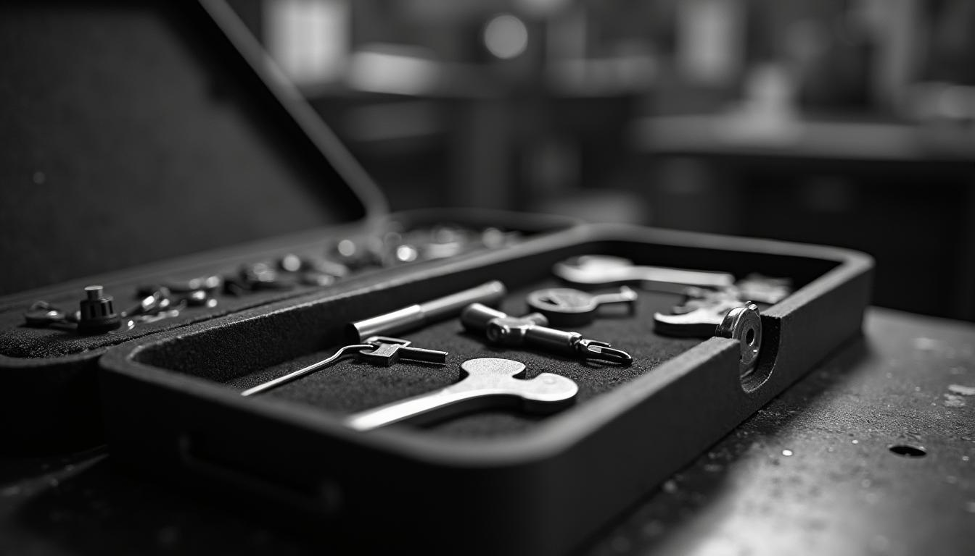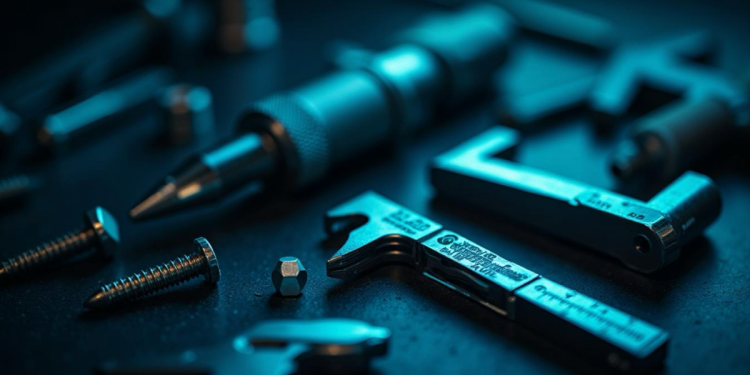You might think that being a locksmith just involves picking locks and making keys, but it’s much more complex than that. To truly understand the breadth of a locksmith’s work, you’ll want to explore the variety of tools they rely on daily. From basic hand tools to advanced electronic equipment, each tool serves a specific purpose vital to their trade. Curious about what these essential tools are and how they enhance a locksmith’s efficiency? The details might surprise you and reveal the intricacies of this skilled profession.
Basic Hand Tools
Locksmiths often rely on basic hand tools to tackle a variety of tasks efficiently. These tools form the backbone of your toolkit and help you perform essential functions with precision.
A reliable set of screwdrivers is vital; you’ll need both flathead and Phillips to manage different types of fasteners. Pliers, especially needle-nose and locking pliers, come in handy for gripping and bending metal components.
Wrenches, including adjustable and socket types, help you loosen or tighten nuts and bolts with ease. It’s also smart to keep a sturdy hammer in your arsenal—sometimes a gentle tap can free a stuck mechanism.
You’ll find that utility knives are essential for cutting through packaging or securing materials during a job.
Measuring tools, like tape measures or calipers, allow you to get accurate dimensions, ensuring a perfect fit for locks and hardware.
Finally, don’t underestimate the importance of a good flashlight; it’ll help you see into dark spaces when you’re working in tight spots.
Lock Picking Tools
When it comes to lock picking tools, having the right equipment is essential for successfully maneuvering through various locking mechanisms.
You’ll find that a basic set typically includes a tension wrench and a variety of picks. The tension wrench applies the necessary pressure to the lock cylinder, while the picks manipulate the pins inside.
You’ll often use hooks, diamonds, and rakes, each designed to tackle different types of locks. A hook pick is great for single pin picking, allowing for precise control over each pin. On the other hand, a rake pick helps you quickly set multiple pins at once, which is useful in less secure locks.
Don’t forget about a good set of lock picks made from durable materials. Stainless steel or high-carbon steel options are popular choices for their strength and longevity.
Consider investing in a practice lock or a transparent lock to hone your skills.
Key Cutting Machines
A reliable key cutting machine is an indispensable tool for any locksmith, streamlining the process of creating duplicates with precision.
Whether you’re working with standard keys or specialized ones, having the right machine makes all the difference in efficiency and accuracy.
Here are four key features to take into account when choosing a key cutting machine:
- Type of Key: Verify the machine can handle various key types, including standard, car, and high-security keys.
- Cutting Method: Look for machines that offer different cutting methods, such as duplicating or milling, to match your specific needs.
- Portability: If you often work on-site, a portable model might be essential for convenience and ease of transport.
- Ease of Use: Opt for a user-friendly interface that allows quick adjustments and settings, making your job easier.
With the right key cutting machine, you’ll not only save time but also improve the quality of your work, guaranteeing customer satisfaction.
Investing in this essential tool will set you apart in the locksmith trade, allowing you to tackle any key-related challenge with confidence.

Electronic Lock Tools
Maneuvering the world of electronic locks requires specialized tools that make the job easier and more efficient. As a locksmith, you’ll want to have a range of electronic lock tools at your disposal to tackle various challenges.
One essential tool is the electronic lock pick, designed to bypass electronic locking mechanisms without damaging them. This tool can save you time and preserve the integrity of the lock.
Another important piece is the key programmer. With many locks relying on transponder keys, having a reliable key programmer allows you to duplicate or reprogram keys on-site. This capability is vital for customer satisfaction, as it minimizes wait times.
You should also invest in a lock decoder. This handy tool helps you understand the pin configuration of electronic locks, allowing you to create new keys accurately.
Security System Equipment
When it comes to securing properties, you can’t overlook security system equipment.
Access control systems, alarm monitoring devices, and surveillance camera integration are essential tools that enhance overall safety.
Understanding how to install and maintain these systems will set you apart as a locksmith.
Access Control Systems
In today’s security landscape, access control systems are essential for protecting both residential and commercial properties. These systems allow you to manage who enters your space, providing peace of mind and enhanced security.
By implementing access control, you’re not just restricting entry; you’re also monitoring and recording access events.
Here are four key components of access control systems you should know about:
- Keypads: These devices allow users to enter a code for access, offering a simple yet effective method of controlling entry.
- Card Readers: Using RFID technology, these readers grant access through ID cards, making it easy to manage permissions for multiple users.
- Biometric Scanners: These advanced systems utilize fingerprints or facial recognition, ensuring that only authorized individuals can gain entry.
- Electronic Locks: These locks integrate with your access control system, allowing remote locking and releasing, enhancing security and convenience.
Alarm Monitoring Devices
Alarm monitoring devices play an essential role in enhancing security for both homes and businesses. As a locksmith, you know how vital it’s to guarantee your clients feel safe and protected. These devices serve as the first line of defense against unauthorized access and potential break-ins.
When you install alarm systems, you’re equipping your clients with technology that detects intrusions and alerts them in real time. Motion sensors, door/window contacts, and glass break detectors are just a few examples of the devices you’ll work with. These tools can be customized to meet the specific needs of each property, making them versatile and effective.
Additionally, connecting these alarm devices to a professional monitoring service provides an extra layer of security. If an alarm is triggered, the monitoring center can quickly notify local authorities, ensuring a swift response.
Educating your clients about the importance of maintaining and testing these devices is vital. Regular updates and checks can prevent any malfunctions that could compromise security.
Surveillance Cameras Integration
Integrating surveillance cameras into security systems is essential for thorough protection. These cameras not only deter potential intruders but also provide critical evidence in case of an incident.
As a locksmith, you know that security goes beyond locks and alarms. Here are four key benefits of using surveillance cameras:
- Real-Time Monitoring: You can observe activities in and around the property from anywhere, ensuring peace of mind.
- Increased Evidence Collection: Footage from cameras can serve as significant evidence for law enforcement during investigations.
- Remote Access: Many modern cameras allow you to access live feeds through your smartphone or computer, keeping you connected while on the go.
- Enhanced Deterrence: The mere presence of cameras can discourage criminal activity, making it less likely that someone will attempt to break in.
When you integrate these cameras with other security components, like alarms and access control systems, you create a thorough safety net.
Diagnostic Tools
When troubleshooting lock issues, having the right diagnostic tools can make all the difference. These tools help you identify problems quickly, allowing you to provide efficient solutions for your clients.
One essential tool is the lock pick set, which lets you assess the internal mechanisms without causing damage. You can determine if a lock is jammed or if there’s an issue with the pins.
Another vital diagnostic tool is a plug spinner. This handy device helps you reset locks that have been picked, allowing you to check if the lock functions properly afterward.
You’ll also want to invest in a tension wrench, which aids in applying the right pressure while picking, helping you diagnose problems more accurately.
For electronic locks, a key analyzer can be invaluable. This tool allows you to read key codes and determine if the key is functioning correctly or if it needs replacement.
Finally, a borescope can help you visually inspect the inner workings of a lock, giving you insights into issues that mightn’t be immediately visible.
With these diagnostic tools, you’ll be well-equipped to tackle any lock problem that comes your way.
Safety Gear and Accessories
Ensuring your safety while working as a locksmith is essential, and having the right gear can make a significant difference.
When you handle various tools and work in different environments, investing in proper safety gear isn’t just a good idea; it’s a necessity.
Here are four essential items you should always have on hand:
- Safety Glasses: Protect your eyes from metal shavings and debris that can fly up while you’re working.
- Gloves: Durable, cut-resistant gloves help prevent injuries while handling sharp tools and materials.
- Knee Pads: If you often find yourself working on the ground or in tight spaces, knee pads can save you discomfort and injury.
- Ear Protection: When you’re using power tools, earplugs or earmuffs can help shield your hearing from loud noises.
Upgrade Your Home Security Today!
Protecting your home is essential, and Keyboss Locksmith is here to help with high-quality, dependable security solutions. From lock installations to key replacements, we have you covered. Visit Keyboss Locksmith to see how we can help you enhance your home security.







